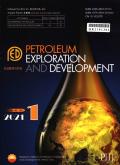Visualization simulation experiments and porosity evolution mechanisms of deep to ultra-deep carbonate reservoirs
IF 8
Q1 ENERGY & FUELS
引用次数: 0
Abstract
To address the challenges in studying the pore formation and evolution processes, and unclear preservation mechanisms of deep to ultra-deep carbonate rocks, a high-temperature and high-pressure visualization simulation experimental device was developed for ultra-deep carbonate reservoirs. This unit comprises four core modules: an ultra-high temperature, high pressure triaxial stress core holder module (temperature higher than 300 °C, pressure higher than 150 MPa), a multi-stage continuous flow module with temperature-pressure regulation, an ultra-high temperature-pressure sapphire window cell and an in-situ high-temperature-pressure fluid property measurement module and real-time ultra-high temperature-pressure permeability detection module. Using the new experimental device and the carbonate rock samples from the Sichuan Basin and Tarim Basin to simulate the dissolution-precipitation process of deep to ultra-deep carbonate reservoirs in an analogous geological setting, the geological insights were obtained in three aspects. First, the pore-throat structure of carbonate is controlled by lithology and initial pore-throat structure, and fluid type, concentration and dissolution duration determine the degree of dissolution. The dissolution process exhibits two evolution patterns. The dissolution scale is positively correlated to the temperature and pressure, and the pore-forming peak period aligns well with the hydrocarbon generation peak period. Second, the dissolution potential of dolomite in an open flow system is greater than that of limestone, and secondary dissolved pores formed continuously are controlled by the type and concentration of acidic fluids and the initial physical properties. These pores predominantly distribute along pre-existing pore/fracture zones. Third, in a nearly closed diagenetic system, after the chemical reaction between acidic fluids and carbonate rock reaches saturation and dynamic equilibrium, the pore structure no longer changes, keeping pre-existing pores well-preserved. These findings have important guiding significance for the evaluation of pore-throat structure and development potential of deep to ultra-deep carbonate reservoirs, and the prediction of main controlling factors and distribution of high-quality carbonate reservoirs.
深层-超深层碳酸盐岩储层可视化模拟实验及孔隙度演化机制
针对目前研究深层至超深层碳酸盐岩孔隙形成演化过程、保存机制不明确等问题,研制了超深层碳酸盐岩储层高温高压可视化模拟实验装置。该装置由四个核心模块组成:超高温高压三轴应力岩心支架模块(温度高于300°C,压力高于150 MPa),具有温度压力调节功能的多级连续流动模块,超高温压力蓝宝石窗口电池和现场高温压力流体特性测量模块和实时超高温压力渗透率检测模块。利用该实验装置,结合四川盆地和塔里木盆地的碳酸盐岩样品,模拟了类似地质环境下深层至超深层碳酸盐岩储层的溶蚀-沉淀过程,获得了三个方面的地质认识。首先,碳酸盐岩的孔喉结构受岩性和初始孔喉结构控制,流体类型、浓度和溶蚀时间决定了溶蚀程度。溶蚀过程呈现两种演化模式。溶蚀规模与温度、压力呈正相关,成孔高峰期与生烃高峰期吻合较好。②白云岩在明流体系中的溶蚀电位大于石灰岩,连续形成的次生溶蚀孔受酸性流体类型、浓度及初始物性控制;这些孔隙主要沿原有孔隙/裂缝带分布。第三,在近乎封闭的成岩系统中,酸性流体与碳酸盐岩化学反应达到饱和和动态平衡后,孔隙结构不再发生变化,使原有孔隙得以保存。这些发现对评价深部至超深部碳酸盐岩储层孔喉结构及开发潜力,预测优质碳酸盐岩储层主控因素及分布具有重要的指导意义。
本文章由计算机程序翻译,如有差异,请以英文原文为准。
求助全文
约1分钟内获得全文
求助全文

 求助内容:
求助内容: 应助结果提醒方式:
应助结果提醒方式:


